I often get people asking me “What’s the best clutch?” It really is a more complicated question than a lot of people think. Everyone drives their car differently, and everyone has different expectations for how a clutch should feel, how long it should last, etc. First, let’s talk about the main different types of clutches that are out there.
Full-Faced Disc
This is the most common type of clutch, which virtually every manual car uses from the factory.
Generally, full-face clutches are going to be the easiest to drive and have the smoothest, quietest operation. However, when you start adding big power, it’s difficult to find a disc clutch that can support those power levels while maintaining a good pedal feel. You usually get increased pedal pressure, chatter, or both, depending on the design of the pressure plate and material of the disc.
Puck Clutches
Puck clutches are named so because instead of a full, circular disc, they have a “star” pattern disc with “pucks” of friction material at each point.
Puck clutches generally have much higher torque capacity than disc clutches, and because they don’t have a full disc, there is less rotating mass, which makes them lighter in weight. A lighter disc allows you to shift faster, as the synchros in the transmission have to do less work to match the speeds of the input and output shafts, since there’s less rotating mass on the input side. Plus, their higher torque capacity means they’re going to tolerate abuse better than “softer” clutches. So they’re great for competition use, in a case that’s going to see drag racing especially. But they do have a few drawbacks. Mainly, they tend to be extremely grabby and often noisy. People often describe them as feeling like they have very “on-off” engagement. They’re not as comfortable to drive on the street for this reason, and because there’s actually less friction material (just higher clamp loads), they won’t last as long as a full-faced disc.
Hybrid Clutches
These aren’t nearly as common, but hybrid clutches are similar to full-face clutches, just with slightly modified designs.
Hybrid clutches really need to be reviewed on a case-by-case basis, because they’re going to be designed for very specific applications or purposes. For example, the above is called the OFE (Organic-Feramic). Literally half of the disc is just like the Organic disc at the top of this page, and the other half is what you’d find on one of Southbends “FE” clutches. We’re seeing the Feramic side, the notches there show the Organic side showing through. Another popular clutch like this is the TZ disc. It’s the same on both sides, but uses a kevlar friction material and a unique design that sets it aside from a traditional full-faced disc.
Multi-Disc Clutches
Multi-Disc clutches are exactly what they sound like. There are multiple discs with friction material stacked up.
These are much less common than other clutch types, primarily due to their cost. They are most often used on motorcycles, where it’s necessary to use a clutch that has a high torque capacity but in a physically smaller space (build up, rather than out). Some multi-disc clutches for cars will employ a similar mentality, where the disc and cover (pressure plate assembly) are much smaller in diameter than the flywheel. In addition to their cost, multi-disc clutches chatter and make noise frequently. While they are known for having relatively light pedal pressure, most are also relatively grabby compared to single disc clutches.
Comparison Charts
So I put together a few diagrams to illustrate more clearly how some of the different clutches we sell compare to one another.
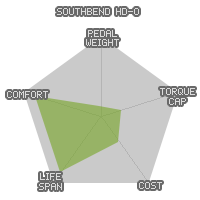 |  |
 | 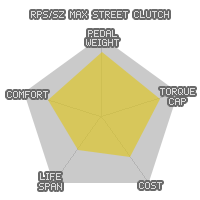 |
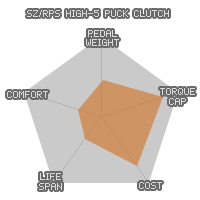 | 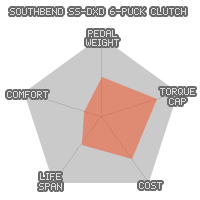 |
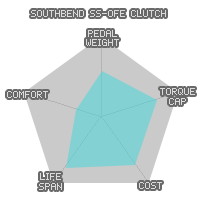 | 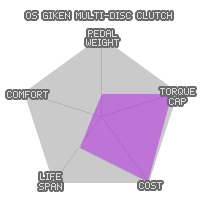 |
Here’s what each value means.
- Pedal Weight – This is how much pressure you have to exert to actuate the pedal. A lower value indicates a lighter pedal. A lighter pedal isn’t always better, though. Many find it difficult to modulate the clutch pedal carefully when it’s extremely light, but if you’re driving the car in traffic every day, you’re not going to want a heavier pedal. Additionally, TT Z32s originally came with clutch boosters to make the pedal lighter. So you may find that a clutch rated as being moderately heavy isn’t too bad in your car if you have it, or a clutch that most find someone light a bit heavier than expected.
- Torque Cap – Indicates how much torque capacity the clutch can handle before slipping. It’s important to note that a high torque capacity doesn’t necessarily mean it can take more abuse. For example, the SS-TZ has a very high torque cap despite how smooth it is, but it’s not recommended for drag racing, for which a puck or multi-disc clutch would be better suited. This is because when you drop the clutch, especially at high RPM, the disc is “shocked” with torque. So even if your engine only makes 300 ft-lbs of torque, if you’re clutch-kicking everywhere, you’re going to wear it out faster.
- Cost – How expensive the clutch is to purchase. Simple, right?
- Life Span – How long the clutch is expected to last. This is a combination of both the type of clutch (for example, puck clutches don’t last as long as full-faced discs) as well as perceived build quality, which is mostly from my own observations having sold these for a while. I should point out that clutches don’t just go bad. I’ve occasionally had someone install a clutch on a car making less power than the clutch is rated, and had the clutch start slipping after only a few months. It’s one thing if the pressure plate breaks physically, or a spring pops out of a disc, but other than that the only thing that can cause the clutch to fail is either incorrect installation or incorrect operation. Slipping the clutch, riding the pedal, launching/drag racing, clutch kicking, downshifting into the wrong gear (reverse torque damage), and improper pedal adjustment are all common/possible causes of clutch failure. On the rare occasion someone tells me they installed a (high quality) clutch in their car and it failed prematurely, I’m always tempted to ask: why are you replacing your old clutch to begin with?
- Comfort – How smooth and quiet the clutch is. The higher this value, the more “streetable” a clutch is. A clutch with a low value here may chatter, chirp, or be difficult to engage without bucking.
This list isn’t complete nor is it totally scientific, but hopefully it helps steer someone in the right direction!

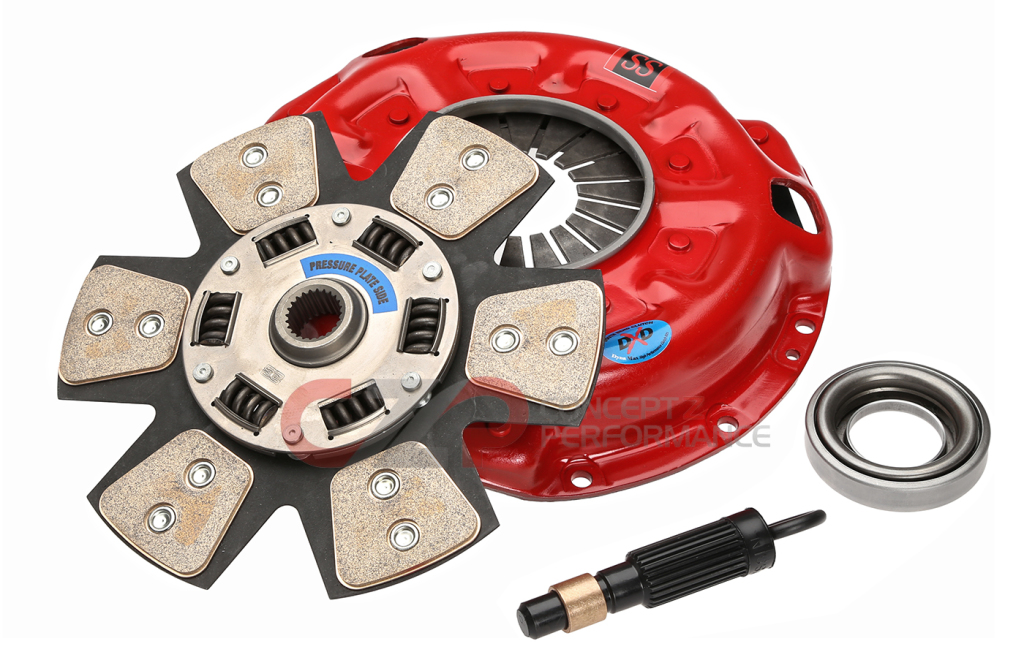


Nicely done Nick.
Thanks Seb!
Fantastic write ups. Easy to understand and very informative, answering questions that give me peace of mind.
Looks like I made the right choice getting the SS-TZ. Very informative write up and very easy to follow. Thanks!
I’m currently running the SS-TZ in my car. It’s one of my favorite clutches.
What’s the part number for that,I have a 1991 n/a 2+2
For which one?
Keep posting these Nick. Good stuff.
I’d be interested in tire selection next, even though you guys don’t deal in them. I’ve had a surprisingly hard time finding a good guide to performance tires. It seems mostly like everyone has their favorite brand, and that’s where it ends. After I’ve picked out my size, there’s still tons of options and words being thrown around: Summer/All-Season, Max/Ultra Performance, Treadware rating, Sidewall rating, Traction rating, Temperatures, Direction/non-directional, etc.
Currently on my 2nd JWT clutch/flywheel in my daily driven n/a Z33. It’s been a phenomenal product, but does tend to chatter a bit.
Very helpful and Great information,
we appreciate advice especially coming from a professional.
Thanks again and keep up the great work!